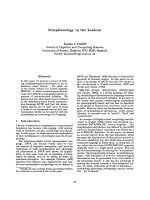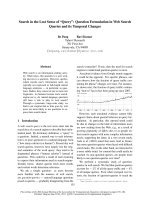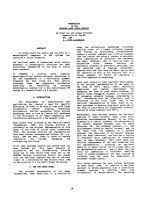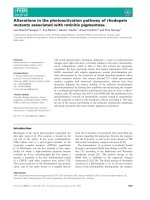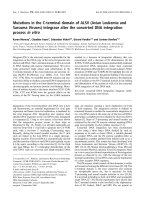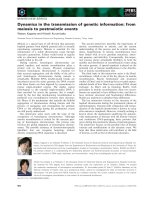Báo cáo khoa học: "Differences in the serum immunoglobulin concentrations between dairy and beef calves from birth to 14 days of age" pdf
Bạn đang xem bản rút gọn của tài liệu. Xem và tải ngay bản đầy đủ của tài liệu tại đây (59.76 KB, 4 trang )
-2851$/ 2)
9H W H U L Q D U \
6FLHQFH
J. Vet. Sci.
(2003),
/
4
(3), 257–260
Differences in the serum immunoglobulin concentrations between dairy
and beef calves from birth to 14 days of age
Guk-Hyun Suh, Tai-Young Hur, Dong-Soo Son, Chang-yong Choe, Young-Hun Jung,
Byeong-suk Ahn, Chai-Yong Lee
1
and Chung-Gil Lee
1,
*
National Livestock Research Institute, RDA, Cheonan 330-800, Korea
1
College of Veterinary Medicine, Chonnam National University, Kwangju 500-757, Korea
The changes in serum levels of immunoglobulins G, M
and A of dairy and beef calves of well-managed herds
were monitored from birth to 14 days post partum using
single radial immunodiffusion. Serum levels of all three
immunoglobulin classes reached its peak at 24 hours in
both groups of calves after birth, at which time there were
very high levels of each immunoglobulin present. The
mean IgM and IgA levels of the two groups became same
at 6 days and 8 days of age, respectively but the mean IgG
level of beef calves was approximately twice that of dairy
calves throughout the experiment.
Key words:
beef calf, dairy calf, serum immunoglobulins
Introduction
During the first two weeks of life, calves are at highest
risk for death and especially during the first week.
Septicemic and enteric diseases are most common in this
period. The failure of passive transfer of colostral
immunoglobulins (Ig) is a major determinant of septicemic
disease during this period [7,15]. It also modulates the
occurrence of mortality and severity of enteric and
respiratory diseases in early life of calves [18].
The major Ig in colostrum is IgG, but there are also
significant amounts of IgM and IgA [4]. Following
ingestion by the newborn calves, a significant proportion
of these Igs ingested in the colostrum is absorbed across
the epithelial cells of the small intestine during the first few
hours of life and transported via the lymphatic system to
the blood [3]. Igs in the blood are further varyingly
distributed to extravascular fluids and to body secretions
depending upon its class [2].
These absorbed Igs protect against systemic invasion by
microorganisms and septic disease during the neonatal
period. Unabsorbed Igs and Igs re-secreted back into the
gut play an important role in protection against intestinal
disease for several weeks following birth [13]. In calves, it
is known that passive immunity also influences the
occurrence of respiratory disease during the first months of
life and may be a determinant of lifetime productivity.
The amount of circulating Igs acquired from colostrum
is primarily dependent upon two factors [1,18]. One is the
amount or mass of Ig present in a feeding of colostrum.
The mass of Ig fed is determined by the concentration of Ig
in the colostrum and the volume that is fed. There can be
substantial variation in the concentration of Ig in colostrum
of dairy cows. And a significant proportion of dairy calves
may fail to ingest adequate colostrum volumes before
onset of the closure process in natural suckling situations
and so early assisted suckling is needed. In contrast, with
beef breeds relatively effective colostral Ig transfer is
achieved with natural suckling.
The other is the efficiency of absorption of Igs by the
calf. Under normal conditions complete loss of the ability
to absorb Ig occurs by 24-36 hours after birth in calves and
there is a significant reduction in absorptive ability by 8-12
hours following birth. Thus, the time from birth to feeding
of the colostrum is a crucial factor affecting the absorption
of colostral Igs. Compared to the beef breeds, natural
suckling of dairy calves is commonly associated with a
high rate of passive transfer failure due to delays in
sucking coupled with low intakes [11,19]. Thus, the
volume of colostrum that is ingested in dairy calves is
controlled in artificial feeding systems using nipple bottle
feeders or esophageal tube feeders [2,5].
The transfer of colostral Igs in both dairy and beef
calves is well documented [10-12]. Kim and Han [8,9]
studied the transfer of colostral Igs in the Korean native
calves. In the present study, attempts were made to find
the differences in the serum Ig concentrations between
dairy and beef calves during the first two weeks of life.
The cows and calves used in this study were from
*Corresponding author
Phone: +82-62-530-2870; Fax +82-62-530-2809
E-mail:
258 Guk-Hyun Suh
et al.
National Livestock Research Institute herds well-
managed with adequate veterinary surveillance and
provision of the nutritional requirements.
Materials and Methods
Cows and calves
Pregnant Korean native cows (20) and Holstein cows
(15) 2-8 years old were chosen from the herds of National
Livestock Research Institute, RDA. Approximately one
day before the estimated calving, each cow was moved
into an individual calving pen (3.4
×
8.0 m) with straw
bedding.
The Korean native calves were born between April and
August 2000, and all the dams and their calves (8 heifers
and 12 bulls) were continuously observed for 6 hrs after
birth. The beef calves stayed with their dams in the calving
pen throughout the experiment so that they could suckle
freely all the time.
The Holstein calves were born between February and
July 2000, and the calves (5 heifers and 10 bulls) were left
with their dams after birth for 30-40 minutes to allow each
dam to clean and stimulate its calf. During the time, 500-
1,000 ml of maternal colostrum was hand-milked from
each dam and bottle-fed to the calf. Calves were then
moved to the individual calf barn bedded with straw and
weighed. The ensuing feedings of colostrum were at
10 : 00 and 16 : 30 next day for five days. The amounts of
whole colostrum fed by bottle were 80 ml/kg BW every
day. From day 6 on, calves were fed whole milk 8% of
their body weight throughout the experiment.
All calves were single-born after normal durations of
pregnancy and normal parturitions. Prevalence of scours
and signs of respiratory tract infections and other
illnesses were monitored daily until the termination of
the experiment.
Sample collection and analysis of immunoglobulin
concentration
Blood samples (10 ml) were collected from the calves by
jugular venipuncture into evacuated containers without
anticoagulant before suckling or colostrum-feeding (0 hrs),
at one and four days, and thereafter at two-day intervals up
to 14 days after birth. Blood samples were allowed to
coagulate, and serum was obtained by centrifugation
(1,500
×
g) for 15 minutes. Serum samples were stored at
−
70
o
C prior to analysis of IgG, IgM and IgA by single
radial immunodiffusion (SRID) test (VMRD
TM
Inc.,
Pullman, USA) [1].
Data analysis
The serum IgG, IgM and IgA concentrations at each
sampling time for both dairy and beef calves were
compared using Student’s
t-
test of SAS [21].
Results
In the present study, no signs of scours, respiratory tract
infections or other illnesses were observed in the calves
from birth to the termination of the experiment.
Serum IgG, IgM and IgA concentrations for dairy and
beef calves from birth to 14 days of age are graphically
represented (Figs. 1-3). As was expected, serum levels of
all three Ig classes reached its peak at 24 hours after birth,
at which time there were very high levels of each Ig
present.
Mean serum IgG levels were significantly higher in beef
calves than in dairy calves throughout the experiment
(p < 0.001). At 24 hours post partum, the mean serum IgG
level reached the peak in both groups of calves; not a calf
in both groups was found to be hypogammaglobulinemic
in the serum IgG level, although individual level varied
between 10.6 and 78.2 mg/ml. The IgG level of beef calves
was more than twice that of dairy calves at that age. After
24 hours, the levels fell gradually, but not significantly
F
ig. 1. Changes in the mean (with standard errors) serum Ig
G
l
evels of Korean native calves (
0
) and Holstein calves (
;
)
d
uring the first two weeks after birth. The serum IgG levels we
re
h
igher in Korean native calves than in Holstein calves througho
ut
t
he experiment (p<0.001).
F
ig. 2. Changes in the mean (with standard errors) serum Ig
M
l
evels of Korean native calves (
0
) and Holstein calves (
;
)
d
uring the first two weeks after birth. The serum IgM levels we
re
h
igher in Korean native calves than in Holstein calves at day 1 a
nd
4
(p<0.05) after birth.
Differences in the serum immunoglobulin concentrations between dairy and beef calves from birth to 14 days of age 259
until 14 days after birth.
Mean serum IgM level reached the peak at 24 hours post
partum in both groups of calves and fell sharply until six
days after birth. Thereafter, it remained steady until 14
days after birth. The level was significantly higher in beef
calves than in dairy calves at 24 hours and four days after
birth (p < 0.05).
Mean serum IgA level reached the peak at 24 hours post
partum in both groups of calves. In beef calves, it fell
sharply at four days after birth and thereafter, it remained
steady until 14 days after birth. In contrast, mean serum
IgA level of dairy calves did not change from 24 hours post
partum to 14 days of age. The IgA level was significantly
higher in beef calves than in dairy calves at 24 hours
(p<0.01), four (p<0.01) and six days (p<0.05) after birth.
Discussion
In a study involving dairy farms in northern California
[14], calf mortality averaged 17.3 to 20.2%. Of all deaths
in calves less than 5 weeks old, 55% occurred during the
first week of life, and 27% occurred during the second
week of life. Later study [15] confirmed that 89% of the
diseased calves that died between 2 to 7 days of age had
not absorbed adequate amounts of Ig. In the present study,
serum IgG, IgM and IgA concentrations for dairy and beef
calves from birth to 14 days of age were determined. All
calves used were single-born after normal durations of
pregnancy and normal parturitions. Signs of scours,
respiratory tract infections and other illnesses were
monitored continuously from birth up to 14 days of age.
No clinical signs were observed in any one of the calves in
both groups during the period. As was indicated, all of
them were from well-managed herds.
The calves in this study had very high levels of three Ig
classes present at 24 hours post partum, and the levels fell
gradually but remained quite high until the end of the
experiment. These data paralleled those in other reports in
both dairy [1,19] and beef calves [9,12,15], except that not
a calf was found to be hypogammaglobulinemic in both
groups of calves in this study.
There is a marked difference in neonatal feeding
methods between dairy and beef calves, and it is well-
known that feeding method can significantly influence on
the serum Ig concentrations of the newborn [12,20]. It was
found in the present study that beef calves had higher
levels of each Ig present. The mean IgM and IgA levels of
the two groups became same at 6 days and 8 days of age,
respectively but the mean IgG level of beef calves was
approximately twice that of dairy calves until 14 days of
age. This could explain that Korean native cattle are more
resistant to the various infectious diseases than dairy cattle.
Natural suckling of dairy calves is known to be
associated with a high rate of passive transfer failure of
colostral immunity due to delays in sucking coupled with
low intakes [11,19]. To help avoid the failure, the volume
of colostrum that is ingested in dairy calves is controlled in
artificial feeding systems using nipple bottle feeders or
esophageal tube feeders. There are various methods used
in early assisted suckling, especially the amount and time
of colostrum feeding after birth [6,16,17]. In view of the
results in the present study, the method employed for early
assisted suckling by National Livestock Research Institute,
RDA seems to be acceptable. The calves did not have
hypogammaglobulinemia from birth to 14 days of age.
References
1. Abel Francisco S. F. and Quigley J. D. Serum
immunoglobulin concentrations after feeding maternal
colostrum or maternal colostrum plus colostral supplement to
dairy calves. Am. J. Vet. Res. 1993, 54, 1051-1054.
2. Arthington J. D., Cattell M. B. and Quigley J. D. Effect of
dietary IgG source (colostrum, serum, or milk-derived
supplement) on the efficiency of Ig absorption in newborn
Holstein calves. J. Dairy Sci. 2000, 83, 1463-1467.
3. Brandon M. R. and Lascelles A. K. Relative efficiency of
absorption of IgG
1
, IgG
2
, IgA and IgM in the newborn calf.
Aust. J. Exp. Biol. Med. Sci. 1971, 49, 629-633.
4. Brandon M. R., Watson D. L. and Lascelles A. K. The
concentrations of immunoglobulins in the blood serum and
whey of dairy cows. Aust. J. Dairy Technol. 1971, 26, 143-
144.
5. Davenport D. F., Quigley J. D., Martin J. E., Holt J. A.
and Arthington J. D. Addition of casein or whey protein to
colostrum or a colostrum supplement product on absorption
of IgG in neonatal calves. J. Dairy Sci. 2000, 83, 2813-2819.
6. Gay C. C., McGuire T. C. and Parish S. M. Seasonal
variation in passive transfer of immunoglobulin G1 to
newborn calves. J. Am. Vet. Med. Assoc. 1983, 183, 566-
568.
F
ig. 3. Changes in the mean (with standard errors) serum Ig
A
l
evels of Korean native calves (
0
) and Holstein calves (
;
)
d
uring the first two weeks after birth. The serum IgA levels we
re
h
igher in Korean native calves than in Holstein calves at day 1 a
nd
f
our (p<0.01) to day 6 (p<0.05) after birth.
260 Guk-Hyun Suh
et al.
7.
Hancock D. D.
Assessing efficiency of passive immune
transfer in diary herds. J. Dairy Sci. 1985,
68
, 163-183.
8.
Kim D. and Han H. R.
A quantitative study of the transfer of
colostral immunoglobulins to the newborn Korean native
calf. Korean J. Vet. Res. 1989,
29
, 75-81.
9.
Kim D. and Han H. R.
Changes in the serum
immunoglobulin levels and viral antibody titers of colostrum-
conferred Korean native calves during the first 12 weeks
postpartum. Korean J. Vet. Res. 1989,
29
, 83-90.
10.
Klaus G. G. B., Bennett A. and Jones E. W.
A quantitative
study of the transfer of colostral immunoglobulins to the
newborn calf. Immunology 1969,
16
, 293-299.
11.
Logan E. F. and Gibson T.
Serum immunoglobulin levels in
suckled beef calves. Vet. Rec. 1975,
97
, 229-230.
12.
Logan E. F., McBeath D. G. and Lowman B. G.
Quantitative studies on serum immunoglobulin levels in
suckled calves from birth to five weeks. Vet. Rec. 1974,
94
,
367-370.
13.
Logan E. F., Stenhouse A., Ormrod D. J. and Penhale W.
J.
The role of colostral immunoglobulins in intestinal
immunity to enteric colibacillosis in the calf. Res. Vet. Sci.
1974,
17
, 290-301.
14.
Martin S. W., Schwabe C. W. and Franti C. E.
Dairy calf
mortality rate: characteristics of calf mortality rates in Tulare
County, California. Am. J. Vet. Res. 1975,
36
, 1099-1104.
15.
McGuire T. C., Pfeiffer N. E., Weikel J. M. and Bartsch R.
C.
Failure of colostral immunoglobulin transfer in calves
dying from infectious disease. J. Am. Vet. Med. Assoc. 1976,
169
, 713-718.
16.
Petrie L.
Maximising the absorption of colostral
immunoglobulins in the newborn dairy calf. Vet. Rec. 1984,
114
, 157-163.
17.
Quigley J. D., Martin K. R., Bemis D. A., Potgieter L. N.
D., Reinemeyer C. R., Rohrbach B. W., Dowlen H. H. and
Lamar K. C.
Effects of housing and colostrum feeding on
serum immunoglobulins, growth, and fecal scores of Jersey
calves. J. Dairy Sci. 1995,
78
, 893-901.
18.
Radostits O. M., Gay C. C., Blood D. C. and Hinchcliff K.
W.
Veterinary Medicine, pp. 137-145. 9th ed. WB Saunders,
London, 2000.
19.
Rajala P. and Castren H.
Serum immunoglobulin
concentrations and health of dairy calves in two management
systems from birth to 12 weeks of age. J. Dairy Sci. 1995,
78
,
2737-2744.
20.
Rauprich A. B. E., Hammon H. M. and Blum J. W.
Influence of feeding different amounts of first colostrum on
metabolic, endocrine, and health status and on growth
performance in neonatal calves. J. Anim. Sci. 2000,
78
, 896-
908.
21.
SAS User's Guide
: Statistics, Version 8.1 edition. SAS
Institute, Inc., Cary, 1999.



